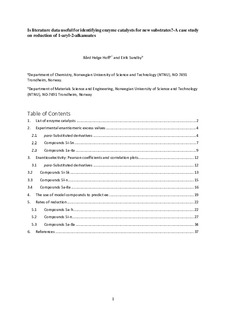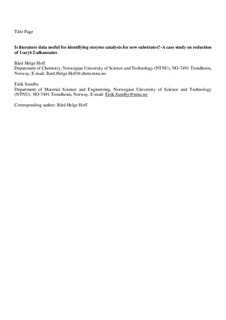| dc.contributor.author | Hoff, Bård Helge | |
| dc.contributor.author | Sundby, Eirik | |
| dc.date.accessioned | 2017-11-10T14:54:49Z | |
| dc.date.available | 2017-11-10T14:54:49Z | |
| dc.date.created | 2017-09-13T19:06:54Z | |
| dc.date.issued | 2017 | |
| dc.identifier.citation | Bioorganic chemistry (Print). 2017, 74 260-271. | nb_NO |
| dc.identifier.issn | 0045-2068 | |
| dc.identifier.uri | http://hdl.handle.net/11250/2465614 | |
| dc.description.abstract | The use of literature data to identify catalysts for a novel transformation is a commonly used approach. Herein, we have evaluated if this is a viable strategy in enzyme catalysis, using asymmetric reduction of 1-aryl-2-alkanoates as a model system. The study, which includes data from 24 ketone substrates and 108 enzymes, clearly identifies pitfalls with this approach, but anyhow shows that literature data is highly useful for identification of enantioselective catalysts. By combining data for selectivity and rate useful catalyst for converting different substrates to their corresponding (R)- and (S)-enantiomers are highlighted. | nb_NO |
| dc.language.iso | eng | nb_NO |
| dc.publisher | Elsevier | nb_NO |
| dc.title | Is literature data useful for identifying enzyme catalysts for new substrates? A case study on reduction of 1-aryl-2-alkanoates | nb_NO |
| dc.type | Journal article | nb_NO |
| dc.type | Peer reviewed | nb_NO |
| dc.description.version | submittedVersion | nb_NO |
| dc.source.pagenumber | 260-271 | nb_NO |
| dc.source.volume | 74 | nb_NO |
| dc.source.journal | Bioorganic chemistry (Print) | nb_NO |
| dc.identifier.doi | 10.1016/j.bioorg.2017.08.005 | |
| dc.identifier.cristin | 1493486 | |
| dc.description.localcode | This is a submitted manuscript of an article published by Elsevier Ltd in Bioorganic Chemistry, 31 August 2017. | nb_NO |
| cristin.unitcode | 194,66,25,0 | |
| cristin.unitname | Institutt for kjemi | |
| cristin.ispublished | true | |
| cristin.fulltext | preprint | |
| cristin.qualitycode | 1 | |

